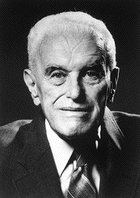Professor John C. Harsanyi


The 1994 Economics Nobel Prize was the first to honour work in game theory, the formal study of conflict and co-operation. It was awarded to John C. Harsanyi from Berkeley, John F. Nash from Princeton, and Reinhard Selten from Bonn, for their pioneering work on noncooperative games. This is the science of "outguessing your opponent", recommending actions based on individual motives.
As it later emerged - grippingly told in Sylvia Nasar's book A Beautiful Mind (1998) on the life of John Nash - the prize was highly controversial in the Nobel committee. It was nearly not awarded, because Nash, who formulated the key concepts in 1950, had become mentally ill from 1960 to 1990. Moreover, many regarded game theory as abstruse and irrelevant.
A Nobel Prize gives its recipient brief public attention, and a permanent shimmer of fame. In this case the limelight was also brought to bear on game theory itself. Interest increased as game theorists became involved in the design of the auctions of radio frequency spectrum for the mobile telecommunications business. These raised billions of dollars in the United States and just recently tens of billions of pounds in Britain and Germany. With so much money at stake, it is likely that participants had started to use the sophisticated analysis suggested by game theory.
The strategic analysis of auctions relies heavily on Harsanyi's most important work, on games with incomplete information, developed in the late 1960s. The "game" played in an auction is defined by more than just the auction's rules. The players' information plays a crucial role, since it determines the price they are willing to pay, and to some extent that is only known to themselves. Not only is this information relevant to a player, but also what the others know about that knowledge. (When you intend to buy a house, for example, you might prefer to conceal some of your enthusiasm from the seller.)
The game can only be analysed, however, reaching a conclusive recommendation for everyone, when all the information about it is fully known, including the uncertain parts about the players' "types", defined by their private information. Harsanyi resolved the intellectual muddle by adding an explicit "history" to a game that generates this uncertainty. With this modelling device, the game can be analysed consistently by classic game theory.
Harsanyi's invention is now a standard tool of "information economics". It broadened the use of game theory because, in real life, most people lack full knowledge about their opponents. Harsanyi's concepts and terminology are used so much that people tend to forget the struggle that led to them. In part, his great ideas were simple and clarifying, so that it is hard to identify why the problem was vexing in the first place.
John von Neumann and Oskar Morgenstern, whose Theory of Games and Economic Behavior started the field in 1944, are long gone. Harsanyi's death, following a heart attack, marks the first major loss from the generation that started to build game theory from 1950 onwards. This group of pioneers met, remarkably intact, at a large game theory congress in Bilbao in July. Its prominent speakers included Nash and Selten, as well as Harsanyi's dissertation adviser Kenneth Arrow, also a Nobel prizewinner. Harsanyi himself, by then suffering from Alzheimer's disease, could not attend.
Harsanyi was born in Budapest in 1920, of Jewish origin. Studying pharmacology to work in his father's pharmacy helped him defer forced labour. He escaped the Nazis in 1944 by hiding in a Jesuit monastery. After a doctorate in philosophy in 1947 from Budapest University and a brief teaching appointment, he fled the increasingly Stalinist Hungary in 1950 to Australia with his wife-to-be, Anne Klauber.
Evening courses at Sydney University - he worked in a factory during the day - brought him an MA in Economics in 1953, and a lectureship in Brisbane followed. In 1956 he went to Stanford University on a Rockefeller fellowship, where he got his PhD in Economics in 1959. He briefly returned to Australia until he emigrated to the United States, where he settled as Professor of Business Administration and Economics at the University of California, Berkeley, in 1964, remaining there until his retirement in 1990.
John Charles Harsanyi, economist: born Budapest 29 May 1920; Professor of Business Administration and Economics, University of California, Berkeley 1964-90 (Emeritus); Nobel Prize in Economics 1994; married 1951 Anne Klauber (one son); died Berkeley, California 9 August 2000.